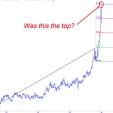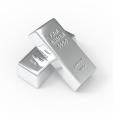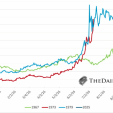Bond Losses Wiped Out for Treasuries With Dollar Beating All
Washington (Sept 22) The prospect of higher U.S. interest rates is proving to be a boon for the biggest owners of Treasuries outside of the Federal Reserve.
While the government bonds have fallen this month as the Fed boosted its forecast for how much rates will rise next year, the dollar climbed to its highest level since 2010 against a broad range of currencies. That’s transformed losses into gains for most foreign holders, who own $6 trillion of Treasuries. The U.S. currency has appreciated so much that Treasuries are the developed world’s best-performing sovereign debt this quarter for investors based in euros, pounds and yen.
Sustaining demand from America’s biggest foreign creditors, such as the Chinese government and Japan’s Kokusai Asset Management Co., is crucial in containing funding costs as the Fed winds down its own extraordinary bond buying and prepares to lift rates for the first time since 2006. With Treasuries offering the highest yields in seven years relative to sovereign bonds worldwide, the dollar’s strength may now help prevent an exodus of overseas investors from upending the $12.2 trillion market for U.S. government debt.
“You’re getting a relatively higher yield by owning Treasuries as well as benefiting from a rising dollar, so the U.S. is going to suck in capital,” Philip Moffitt, the Sydney-based head of fixed income for Asia-Pacific at Goldman Sachs Asset Management, which oversees $935 billion globally, said in an e-mail response to questions on Sept. 19.
With the amount of U.S. public debt almost doubling since the financial crisis erupted in 2008, the stakes have never been higher for Fed Chair Janet Yellen.
Rate Alarm
As she tries to extricate the central bank from six years of near-zero benchmark rates and trillions of dollars of debt purchases, any slack in demand for Treasuries may trigger a jump in borrowing costs for the government, companies and consumers. That threatens to upend the U.S. economy, which is still growing slower on average than before the credit crisis.
After advancing 4.45 percent in the first eight months of the year, Treasuries have lost 1.1 percent in September, the most this year, index data compiled by Bloomberg show.
The selloff deepened as Fed officials last week raised their median rate projection for the end of 2015 by a quarter-percentage point to 1.375 percent. That pushed benchmark 10-year note yields as high as 2.65 percent on Sept. 19 from a low of 2.3 percent on Aug. 15. They ended at 2.57 percent last week. The yield declined to 2.56 percent today as of 12:43 p.m. in Tokyo.
The revision came as the Fed stayed on course to end its quantitative easing next month by cutting monthly bond buying to $15 billion from $25 billion in September, while sticking with language that rates will say low for a “considerable time.”
Currency Translation
While the risk of tighter Fed monetary policy has rattled some bond investors, it’s also caused currency traders to pile into the dollar. The U.S. tender has appreciated against the 16 most-traded major currencies tracked by Bloomberg this quarter.
Over that span, the Bloomberg Dollar Spot Index has gained 5.2 percent, the most for a quarter since 2011.
“Currencies are going to make up the largest part of investment returns now,” Masataka Horii, who helps manage Kokusai Asset’s $9.86 billion Global Sovereign Open Fund, said in an interview on Sept. 11.
Kokusai, the biggest Japanese mutual-fund investor in Treasuries, according to data compiled by Bloomberg, is paring holdings in yen and euros to buy more U.S. debt. The fund had 30.3 percent of its assets in dollar investments as of Sept. 11, versus 28.2 percent on Aug. 29, its website showed.
For overseas investors, that’s translated into world-beating gains on Treasuries, even as prices declined.
Monetary Shift
While U.S. government bonds have fallen 0.45 percent since June, in euros, they returned 6.7 percent including interest payments. That exceeds the bond gains of every developed nation which uses the common currency and is quadruple the 1.7 percent advance for German bunds, data compiled by Bloomberg show.
Treasuries have done even better for yen-based investors, returning 7.6 percent as the dollar soared to a six-year high against the Japanese currency. That compares with a 0.2 percent local-currency return for the Asian nation’s bonds. U.K., Swiss and Canadian investors would have also earned more on Treasuries than from holding their own governments’ securities.
With the Bank of Japan buying 7 trillion yen ($64 billion) of bonds each month to support its economy and the European Central Bank moving closer to starting its own quantitative easing to prevent deflation, the prospect of more yen and euros flooding into the financial markets as a result has forecasters predicting the dollar will appreciate even further.
No Value
The greenback will rally against nine of 10 major currencies by the end of 2015, based on strategists’ estimates compiled by Bloomberg.
Jeffrey Gundlach, who oversees $52 billion as co-founder and chief investment officer at Los Angeles-based DoubleLine Capital LP, told clients in a webcast on Sept. 9 that owning non-dollar securities didn’t make sense and the U.S. tender’s gains were attracting overseas buyers to Treasuries.
Just last week, foreign central banks, which are among the biggest buyers of U.S. government bonds, increased their stakes held in custody by the Fed to a record $3.03 trillion.
With economists projecting the fastest U.S. growth in a decade next year, Threadneedle Asset Management Ltd.’s Toby Nangle says he’d rather invest in dollars as the Fed boosts borrowing costs than risk putting money into Treasuries.
Retail sales picked up in August and July, while consumer confidence rose to the highest level in more than a year in September, separate reports showed this month.
History Lesson
“Just because we like the dollar doesn’t mean that we then go and invest in Treasuries,” Nangle, who helps manage $159 billion as the London-based head of multi-asset allocation at Threadneedle, said in a telephone interview on Sept. 19. “We don’t see value in Treasuries.”
The last time the Fed started raising rates, in June 2004, the dollar’s strength against the yen, euro and pound bolstered U.S. debt returns for a wide range of overseas investors.
Japanese holders were rewarded with the biggest gains as the greenback’s rally in the first year of tightening turned a 7.2 percent return for Treasuries into a 9.1 percent advance in yen, data compiled by Bank of America Merrill Lynch show.
Higher relative yields also enhance the appeal of U.S. debt at a time when turmoil from Russia to Gaza has sustained demand for the safest assets, said Jim Leaviss, a London-based money manager at M&G Investments, which oversees $389 billion.
Ten-year notes yielded 1.57 percentage points more than German bunds last week, the most since 1999. The gap has expanded at a faster pace since June, when the ECB became the first major central bank to take one of its main rates negative.
Yield Premium
Globally, Treasuries yield 0.62 percentage point more than other sovereign bonds, the biggest advantage since 2007.
“The dollar is also attractive as a safe-haven currency in the world where you have geopolitical risks,” Leaviss said by telephone Sept. 16. “And if you look at the other economies around the world, U.S. yields are relatively attractive.”
The dollar’s advance has helped to contain inflation by pushing down the price on a range of commodities to a five-year low. The cost of living in the U.S. dropped in August for the first time in more than a year, with consumer prices falling 0.2 percent from the previous month.
Based on the Fed’s preferred measure, inflation on an annual basis has fallen short of its 2 percent target for 27 straight months. The lack of pricing pressure may lessen the need for the Fed to move aggressively in raising rates and preserve the purchasing power of fixed-income payments.
“With commodity prices, inflation will be heading south,” Hideo Shimomura, the chief fund investor at Mitsubishi UFJ Asset Management Co., which oversees $75 billion, said in a Sept. 16 telephone interview from Tokyo. As for Treasuries, “we don’t have any fear of a selloff.”
Souce: Bloomberg












